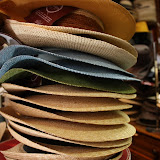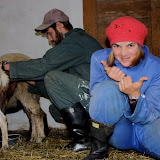guest blogger: Christie Sumner
After our day into, and night overlooking Ngorongoro Crater, we loaded up the “cruiser” with tents, mattresses, pots and pans, and our packs, etc and headed to our next adventure, walking and camping with Good Earth across the Ngorongoro highlands. After setting up camp in a small village of Nanokanoka, meeting our cook, Othman (my personal favorite of all personnel), we were introduced to “our” ranger, Adrian, who took us for a warm-up hike to see Olmoti crater, lake and waterfall. Once he cocked his rifle, we understood we were still in wild territory. On foot, we encountered our first interested village kids, who tag along, but who want money or any other thing we might unload upon them, particularly if we want to take their picture. A few made the entire few hour trek with us and we “got to know” them a bit. First night camping, we settled in, found the outhouse with the hole in it, organized gear, and had a great dinner. Another group arrived and set up as well, and enjoyed a late night (!) in their cook tent. In the morning, after fruit, eggs, toast and peanut butter, we packed up and headed out with Adrian across meadows and through Massai villages, following cattle tracks and, for many hours in the sun, down and across the Embulbul Depression. We came upon a resting group of teenagers from a local village, on their way to Nanokanoka. Several were dressed in the Massai red check wraps, one in modern dress and leather jacket but wrapped in his red check and one just modern dress. Most had cell phones. The two were home on break from secondary school in Arusha. After much discussion regarding their studies, Ryan exchanged email addresses and we all pushed off in our respective directions. We could see our yellow tents set up and six hours later we arrive at a widely spread Massai village, where some children walk up to 12 kilometers to school, carrying a milk-filled calabash or a plastic jug of water. A recess “football” game incorporating most of the 600 students was in full swing when we arrived. Ryan jumped right in and ended up as the spire in the middle of a screaming group of brown heads. Annie got her turn as she lay on the ground in a circle of children showing her their “pretty healthy” teeth! Ryan walked partway with the excited kids after school. As we were in the highlands, it was cool at night, so out came the hats and extra layers. Othman figured out that “Mama” likes her tea at 4pm, so that became the norm, along with popcorn. More great meals followed. Next morning, after a quick stop at the primary school (we hadn’t planned on bringing a monetary donation, and “Mama’s” bag of goodies was left behind, so we didn’t have “comfortable” access) where 600 kids are taught by 2 teachers, we headed out with Adrian and his gun, once again following the cattle tracks over hill and dale, beautiful enormous landscape, to our next campsite. Annie, Ryan and Adrian hiked down to Embakaai Crater Lake. We traveled over dirt road the next day to Naiyobi village. On this trek, we passed several groups of girls/women, who wanted to sell us their crafts. We also happened upon Freddy, about 8 years old, in tattered brown. He was very shy, but turned back and followed us about 3 kilometers to the village. Ryan was able to break him out a bit. As we reached the village, another boy joined us and his name was also Freddy. As a matter of fact, by the time we got to our tents, we’d met about five Freddys. Freddy I hung around that afternoon, and came back in the morning, the only thing changed was the order of his sweater/t-shirt layering. We finally “had” him when we started sharing our pictures and letting the kids take pictures with our cameras. That was, in the end, the way we came to an understanding with the Massai people, by sharing our time: through photography, play, sharing our crafts (knitting) and talents (singing, whistling, drumming). We finally saw them smile, laugh and embrace us.
The final six hour push to Lake Natron involved 3 donkeys piled with our packs and camping gear, 3 Massai men, Othman and us in a caravan through cattle, sheep and goat herds, down from the ash-strewn (from 2007 eruption of Lengai volcano) highlands, where we met our new guide/driver, Joseph, and sorted out the men and donkeys (all Massai and donkeys were turned back for another six hour trek home!).
At this point, “Mama” considered her options: to climb Lengai or not. Heck, we had about six hours to rest before starting up at midnight! There was a full moon. It was billed as a “strenuous” hike, but with the “possibility” of an amazing sunrise! Hmmm. When Elie taps on your tent at 11pm, you really should have made a decision; but barring that, you’re awake, so you might as well go. With full moon, clear night, we rarely needed our headlamps at all. The gradual uphill climb on fairly hard surface was a real fooler for things to come, as the surface became ash/pumice and the grade went quickly from gradual to steep, then steeper. It was pretty much like climbing a sand dune for 4 hours, polle polle (slowly, slowly). We fell into a line with Ryan stamping up sideways, crossing over to make “steps” for Annie and “Mama.” And, “Mama” muttering from time to time: “How are we going to get down?” “Why are we doing this?” After Elie announced that he often takes Americans, and that Chicagoans make it to the top, but San Franciscans usually turn around half-way, well, the challenge was laid down for Vermonters, so the muttering continued, “We are really being stubborn!” At some point, we realized the moon was no longer with us, and, then, about 45 minutes from the top we heard the rain. When it arrived we hunkered down under Elie’s poncho for about 10 minutes, but I guess he knew the trip was over and it was time to get off the volcano as quickly as possible. How are we going to get down? Run! We could hear the rushing water filling the gullies on each side of us (“This is something you don’t tell your mother!”). Headlamps and glasses were of little use in the clouds, fog and rain. Just stay close and follow the person ahead. Sopping wet, back in the cruiser, we still had to cross now-swollen riverbeds. The black water surged as the hikers crashed for about an hour, waiting for a break. Having just heard a story of a guide being swept away in his vehicle and drowning, did not evoke confidence. But, we made it across and back to camp and one of Othman’s great breakfasts. Finding something dry to put on was a challenge, but we did, loaded the cruiser and headed toward our next adventure at Lake Eyasi.
 Truth be told the trip was ACE (thanks for that Sir Alex) - blue water, dolphins, flying fish, lots of smiles if not good conversation from our mates - and an unforgettable trip which would have been uneventful comfortable and boring otherwise. That’s how you make memories… proactively.
Truth be told the trip was ACE (thanks for that Sir Alex) - blue water, dolphins, flying fish, lots of smiles if not good conversation from our mates - and an unforgettable trip which would have been uneventful comfortable and boring otherwise. That’s how you make memories… proactively.

